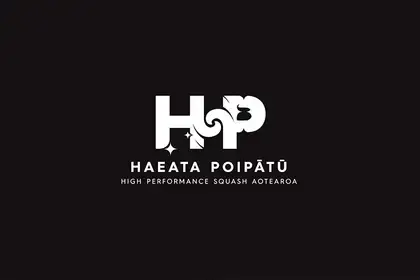
The new High-Performance emblem for Squash New Zealand, Haeata Poipātū.
Massey University’s School of Sport and Exercise lecturer Jeremy Hapeta and Massey Business School student Regan Smith, who is majoring in marketing with a minor in psychology, have been thanked by Squash New Zealand’s chief executive Jim O’Grady for the concept and design of their new High-Performance emblem Haeata Poipātū.
Mr Hapeta (Ngāti Raukawa), who acts as the cultural (Māori) advisor for High-Performance Squash NZ recently presented the culturally inclusive concept at the New Zealand National Squash Championships held in Hawke’s Bay, with Mr Smith.
Mr Hapeta says the idea originated from the aspirations of former New Zealand Men’s Number 1 and former Squash New Zealand High-Performance manager, Kashif Shuja. Mr Shuja is now Massey University’s sports development officer and through this association became familiar with Mr Hapeta’s research in the area of entho-cultural inclusiveness in New Zealand sport settings. It was also Mr Smith’s father, Palmerston North Mayor Grant Smith, who designed the original logo for Squash New Zealand.

Former Squash champion Shelley Kitchen, Jeremy Hapeta and Squash NZ chief executive Jim O'Grady.
Haeata describes the first rays of light at sunrise or the glow at dawn, and Poipātū is the Māori word given to mean Squash (Poi, a circular-shaped ball; Pātū, to hit or strike). Together they literally mean ‘a new dawn for Squash’ in Aotearoa New Zealand.
With 30 per cent of New Zealand’s Top 10 men’s and women’s players having Māori whakapapa (genealogy), Mr Shuja identified an opportunity for Squash New Zealand to become more inclusive of ethnic diversity. The aim was to inspire a greater sense of pride in where their athletes came from, who they were as people not just as elite-level Squash players, and the people who they represented on the international sporting stage.
Mr O’Grady personally thanked the pair for gifting them the emblem that will help unify New Zealand squash players – especially those based overseas. The logo is the result of two and a half years of workshopping, presentations, meetings and awareness raising on the importance of cultural meanings to a group, as detailed in Mr Hapeta’s research successes of a similar nature within New Zealand rugby in recent years.

Emblem graphic designer and Business School student Regan Smith.
Mr Hapeta says the gifting of the HP ‘koha’ (emblem) was symbolic of and in alignment with puanga-Matariki, the blossoming of a constellation of stars which signals the beginning of the Māori New Year. “It is a new beginning. Matariki is a time of harvest and celebrating the ‘fruits’ of the past year. It is also a time to plan for the year ahead and to plant seeds for future harvests. Therefore, with the 2018 Commonwealth Games fast approaching, the timing was appropriate to unveil Haeata Poipātū for Squash NZ’s High-Performance athletes; especially with their sights set firmly on medals in April, 2018.
“While the depth of meanings and symbolism embedded within the emblem are too vast to go into in this article, all of the HPSNZ players, coaches and administrators collectively involved in the programme know who they represent and what their new emblem stands for,” Mr Hapeta says.
The Design team also wish to acknowledge and thank School of Māori Art lecturer Israel Birch for his input and expertise in shaping the final artefact.